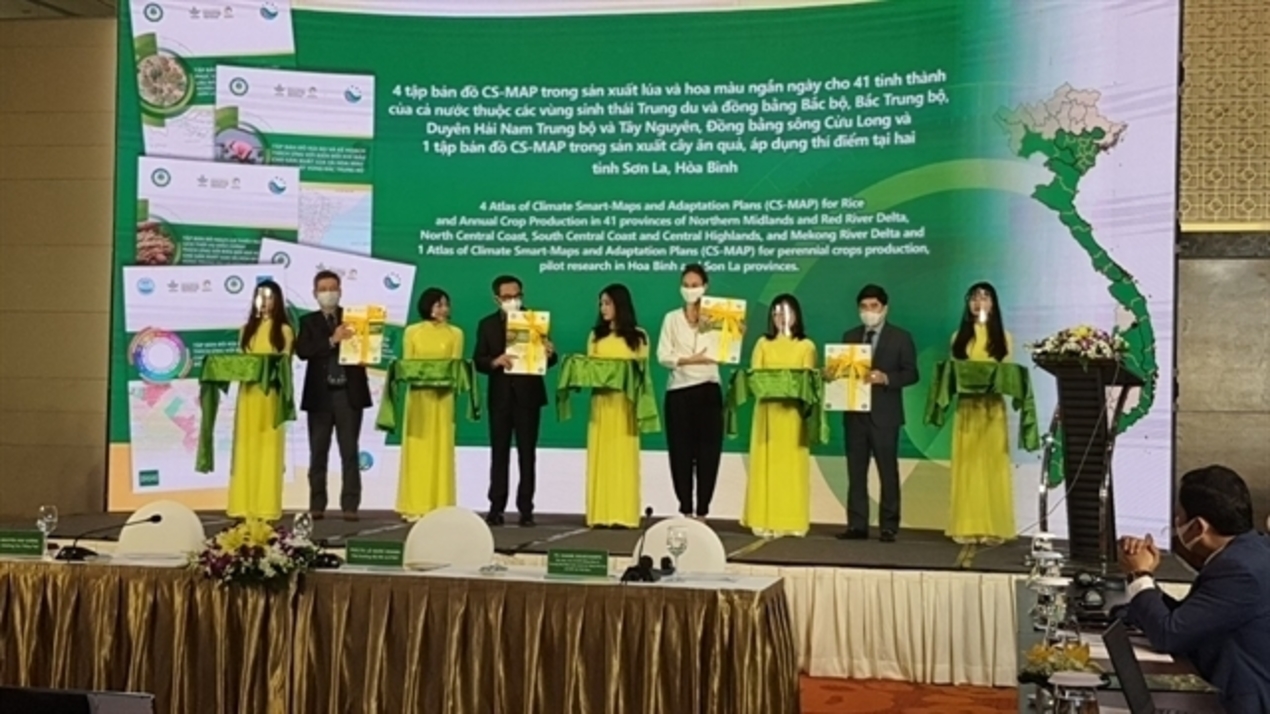
To help farmers manage climate-related risks such as flooding, drought, and saline intrusion, the Ministry of Agriculture and Rural Development has launched the Climate-Smart Maps and Adaption Plans (CS-MAP). CS-MAP integrates local knowledge and science-based research to provide location-specific risk maps and adaptation plans for rice production. The project currently covers five ecological regions of Vietnam and was developed by the Ministry’s Crops Production Department and CGIAR Research Programme on Climate Change, Agriculture, and Food Security in Southeast Asia (CCAFS SEA).
CS-MAP engages experts from the national and local levels to:
- Identify climate-related risks
- Determine potentially affected areas and their risk levels using technical, infrastructure and topographic data, and local knowledge
- Assess and improve proposed adaptive measures
- Develop integrated adaptation plans for rice production from regional to provincial levels
Maps of flooding and salinity intrusion risks were developed by integrating scientific evidence provided by researchers and experts with local knowledge of stakeholders on topography, infrastructure, hydrological management schemes, and land use plans. Based on the risk maps, adaptive rice production calendars for moderate intensity and duration (normal year) and extreme intensity and prolonged duration (severe year) were generated. Through a series of consultations with provincial and regional stakeholders, the cropping schedules were proposed, not only to address various climate-related risks, but also to ensure sharing of resources and the harmonisation of policies concerning water, labor, infrastructure, and information.
According to a news report, a conference for the launch of CS-MAPS was held in Hanoi last week, organised by the Department of Crop Production (DCP) of CCAFS SEA. The socio-economic impact of the project at both a national and international level was discussed, as well as ways policies can be developed in support.
At a local level, CS-MAP is a tool for climate change adaptation and disaster prevention. It will likely be included in the socio-economic plan for the period 2021-2030, an action plan to respond to climate change for the period 2021-2030, and agricultural land use planning including rice land conversion. At the event, an instructional video and five atlases were inaugurated to help guide the use of CS-MAPS. Using colourful illustrations and animations, the video is an easy-to-understand and enjoyable reference to materials on CS-MAP.
DCP and CCAFS SEA have also published a guidebook, to help technical officers and professional agencies at different administrative levels implement CS-MAP. Both the guidebook and instructional video are available in English and Vietnamese. Five compilations of CS-MAP’s, for the major agro-ecological regions of Vietnam, were launched at the event. These publications contain maps, both for normal and extreme years, covering 43 provinces of the country. All materials are publicly accessible on CCAFS SEA websites.
Vietnam’s agricultural export turnover reached US$41.53 billion, an increase of 3.3% compared to 2019. Particularly in the first 9 months of this year, export of agricultural products reached US$35.5 billion, up to 18% over the same period last year. Of that, the export of crop products reached US$15.8 billion.
Chairing policy dialogue on the use of CS-MAP, Deputy Minister of Agriculture, Le Quoc Doanh, noted that the CS-MAP would be helpful to farmers in planning production schemes and increase the efficiency of soil and water resource use. Doanh said that Vietnam’s agriculture plays an important role in ensuring food security, social stability, and livelihoods for over 60% of the population in rural areas, contributing 14.85% of the country’s GDP. Despite the impact of the COVID-19 pandemic, climate change, and natural disasters, agriculture has maintained a high growth rate, ensuring food security for nearly 100 million people in Vietnam in 2020.
CS-MAP can be integrated into national and local policies and plans, such as in the National Plan to Adapt to Climate Change, Nationally Determined Contribution to Climate Change Mitigation in the Agricultural Sector, and the National and Regional Agricultural Restructuring Plan for the Period 2021-2025.
















